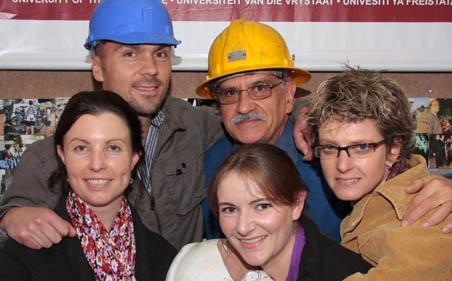 |
The members of the research group are, from the left, front: Christelle van Rooyen, Mariana Erasmus, Prof. Esta van Heerden; back: Armand Bester and Prof. Derek Litthauer.
Photo: Gerhard Louw |
A research article on the work by a team of experts at our university, under the leadership of Prof. Esta van Heerden, and counterparts in Belgium and the USA has been published in the distinguished academic journal Nature today (Thursday, 2 June 2011).
The article – Nematoda from the terrestrial deep subsurface of South Africa – sheds more light on life in the form of a small worm living under extreme conditions in deep hot mines. It was discovered 1,3 km under the surface of the earth in the Beatrix Goldmine close to Welkom and is the first multi-cellular organism that was found so far beneath the surface of the earth. The worm (nematode) was found in between a rock face that is between 3 000 and 12 000 years old.
The research can shed some new light on the possibility of life on other planets, previously considered impossible under extreme conditions. It also expands the possibilities into new areas where new organisms may be found.
These small invertebrates live in terrestrial soil subjected to stress almost for 24 hours They live through sunshine, rain, scorching temperatures and freezing conditions. Through time they developed a means to cope with harsh conditions. Terrestrial nematodes (roundworms, not to be confused or related to earthworms) are among those very tough small invertebrates that deal with those conditions everywhere. After insects they are the most dominant multi-cellular (metazoan) species on the planet having a general size of 0,5 to 1 mm and are among the oldest metazoans on the planet, Nature says in a statement on the article.
They inhabit nearly every imaginable habitat form the deep seas to the acid in pitcher . Some nematodes simply eat bacteria and these are the ones we study here. Terrestrial nematodes have developed a survival stage that can take them through hard times (absence of food, extreme temperatures, too little oxygen, crowding, and more).
At the head of the research was Prof. Gaetan Borgonie of the Ghent University in Belgium and a world leader in the discipline of nematode research. He was brought into contact with the South African research leader, Prof. Esta van Heerden, who set up a cooperation agreement with the University of Ghent and Prof. Borgonie. Prof. Van Heerden manages the Extreme Biochemistry group at the UFS and the research was funded by several research grants.
The search for worms began in earnest in 2007, but it was soon clear that the sampling strategy was insufficient. A massive sampling campaign in 2008-2009 in several mines led to the discovery of several nematodes and the new nematode species Halicephalobus mephisto. It is named after the legend of Faust where the devil, also known as the lord of the underworld is called Mephistopheles.
Nature says special filters had to be designed and installed on various boreholes. Unfortunately, there is no easy way of finding a magic formula and designs had to be adapted by trial and error; improving existing designs all the time. The work of the UFS Mechanical Workshop, which manufactured, adapted and helped design it, was crucial in this respect. Filters were left on the holes for varying periods, sometimes for a few hours and sometimes for months. Prof. Derek Litthauer from the UFS played a big role in sampling, filter designs and coming up with ideas for names for the new nematode with Prof. Borgonie.
Research showed that the nematodes can live in the deep for up to 12 000 years. Three students – Armand Bester, Mariana Erasmus and Christelle van Rooyen from the UFS – did the work on this.
The importance of multi-cellular animals living in the ultra-deep subsurface is twofold: The nematodes graze on the existing bacterial population and influence their turnover. Secondly, if more complex multi-cellular organisms can survive in the deep subsurface on earth, this may be good news when looking for life on other planets where the surface is considered too inhospitable (e.g. Mars). Complex life forms can be found in ecosystems previously thought to be uninhabitable. Nature says this expands the possibilities into new areas where new organisms may be discovered.
Future research will focus on selective boreholes to look for more metazoans, so that a better idea of the complexity of the ecosystems there can be obtained. It will also look for metazoans in the deep subsurface on other continents to determine similarities and differences.